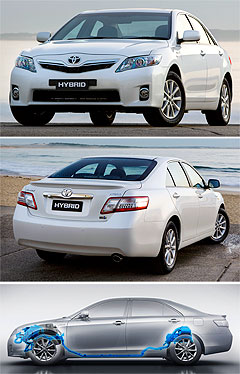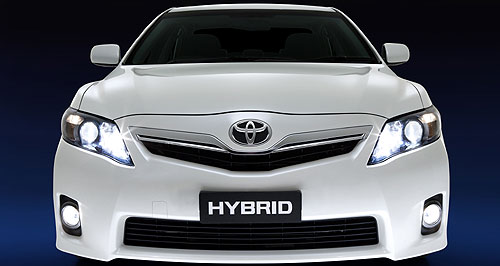Make / Model Search
Future models - Toyota - Camry - HybridCamry Hybrid to return just 6.0L/100kmSuper six: The new Camry Hybrid is set to hit the showrooms next month with a 6.0L/100km fuel consumption rating. Toyota reveals better than expected fuel consumption figures for Camry Hybrid20 Jan 2010 AN OFFICIAL average fuel consumption figure of just six litres per 100km and CO2 emissions of only 142 grams per kilometre will make next month’s Camry Hybrid the most economical model in Toyota’s Australian model range. The better than expected ADR 81/02 numbers have been revealed in a promotional video on Toyota Australia’s public news website ahead of the launch of Australia’s first locally built petrol-electric model on February 8. With pre-prototype media drives of the Camry Hybrid staged in September, its locally developed bodykit presented in December and key specifications already revealed, all that remains unknown about the Aussie Camry Hybrid is its price, which is expected to start under $35,000. Toyota had previously heralded CO2 emissions of less than 150g/km and fuel consumption in the “low-6.0L/100km” regions, but according to the official government-approved numbers the Camry Hybrid will be as efficient as the most frugal Yaris light-car, the YR three/five-door. They also prove Toyota’s claim the Camry Hybrid will use at least 35 per cent less fuel than locally built six-cylinder models, Holden’s Commodore (which uses as little as 9.3L/100km in 3.0-litre MY2010 base form), Ford’s Falcon and Toyota’s own Aurion, both of which return as little as 9.9L/100km.  Previously, Toyota said that compared with the “most fuel-efficient big Aussie six”, the Camry Hybrid would use 40 per cent less fuel on the official urban cycle and 25 per cent less on the highway cycle. Previously, Toyota said that compared with the “most fuel-efficient big Aussie six”, the Camry Hybrid would use 40 per cent less fuel on the official urban cycle and 25 per cent less on the highway cycle.Naturally, the Camry Hybrid will also shatter the efficiency specifications of the Camry Hybrid’s most direct mid-size sedan rivals such as the Honda Accord Euro (8.9L/100km), Toyota’s own petrol Camry (8.8L/100km), Mazda6 (from 8.0L/100km), Subaru Liberty (8.4), Kia Magentis (8.0) and Holden Epica (7.6). However, although hybrids traditionally emit less CO2 than equivalent diesel vehicles, the Camry Hybrid’s fuel-efficiency is still only average compared to mid-size oil-burning rivals such as Skoda’s Octavia (5.7L/100km), the Volkswagen Jetta and Peugeot 407 (5.9), Hyundai Sonata and Renault Laguna (6.0), Volkswagen Passat (6.6), Chrysler Sebring and Dodge Avenger (6.7) and Ford’s Mondeo (7.3). While Toyota Australia’s no-diesel policy for the Corolla sees the Japanese giant’s small-car return a best of 7.4L/100km, Holden’s Korean-made Cruze sedan – production of which will shift to Adelaide in March next year – also undercuts the petrol-electric Camry at 5.7L/100km in diesel guise (from $24,490). Also confirmed for the Camry Hybrid is a maximum power output of 140kW – despite the fact its motor-assisted 110kW 2.4-litre four-cylinder petrol engine will be down on performance compared to the standard Camry’s 117kW output. As we reported after our first drive, however, the Camry Hybrid’s electric engine not only delivers more torque and better acceleration than the garden-variety Camry, its unique suspension tune also makes it a crisper drive – despite being 60kg heavier. At least one specification of the Camry Hybrid will be available, with all examples featuring a drive-by-wire ‘e-CVT’ transmission, an outstanding 0.27Cd aerodynamic drag coefficient, specific bumpers, LED tail-lights and a 389-litre boot with 60/40-split folding rear seat. As with Toyota Australia’s recently facelifted regular Camry models, the hybrid will come standard in entry-level guise with 16x6.5-inch alloy wheels and 215/60-section tyres, six airbags, foglights and Bluetooth connectivity, while a sunroof and premium sound system with satellite-navigation and a reversing camera will be optional. Production commenced in mid-December and Toyota Australia expects to sell 10,000 examples of the Camry Hybrid in its first year, with private buyers accounting for 40 per cent of sales – up from 24 per cent for the Camry previously.  Read more21st of December 2009  Camry Hybrid cuts the dragToyota says aero tweaks make Camry Hybrid most slippery local car with 0.27Cd11th of December 2009  First official look: Toyota's Camry Hybrid is road-readyToyota marks the start of production for its Camry Hybrid two months before salesAll future modelsCamry pricing
Motor industry news |
Click to shareToyota modelsResearch Toyota All future modelsCamry pricing
Motor industry news |



 Alfa Romeo
Alfa Romeo Abarth
Abarth Audi
Audi Aston Martin
Aston Martin BMW
BMW Bentley
Bentley Ferrari
Ferrari Chevrolet
Chevrolet Ford
Ford Fiat
Fiat GWM
GWM Foton
Foton Hyundai
Hyundai Honda
Honda Jaguar
Jaguar Isuzu
Isuzu Kia
Kia Jeep
Jeep Land Rover
Land Rover Lamborghini
Lamborghini Maserati
Maserati Lexus
Lexus McLaren
McLaren Mazda
Mazda Mercedes-Benz
Mercedes-Benz Mitsubishi
Mitsubishi Mini
Mini Peugeot
Peugeot Nissan
Nissan Ram
Ram Porsche
Porsche Rolls-Royce
Rolls-Royce Smart
Smart Skoda
Skoda Suzuki
Suzuki Subaru
Subaru Toyota
Toyota Tesla
Tesla Volvo
Volvo Zeekr
Zeekr







Facebook Twitter Instagram